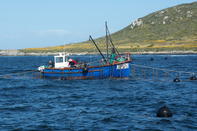Mussels are commercially farmed in Saldanha Bay on the West Coast of South Africa, an area known for nutrient-rich seawater in a naturally sheltered bay. Production systems include long lines and rafts to produce mussels that can be harvested within seven months.

History of Mussel Production
Mussel production was first practised on poles in Spain in the early 1900s, but this method of mussel farming was later abandoned in favour of floating structures. Eventually, in 1946, mussel production boomed with the use of raft culture of mussels. In raft culture, mussels are grown on ropes or a socking material hanging from a floating platform. Often ropes on long lines with floating buoys or, less commonly, rack systems, are used.
Mediterranean mussel, Mytilus galloprovincialis, was introduced to South Africa in the 1970s, but the first mussel farm was only developed in 1981, in Saldanha Bay, to farm indigenous brown mussels, Perna perna, and black mussels, Choromytilus meridionalis, in a tidal pool. At the same time, the Fisheries Development Corporation started seeding mussels in the Knysna Lagoon and in 1986, near Port Elizabeth, the first mussel raft in South Africa was deployed, also seeded with brown mussels.
Mussel Production in South Africa
Mussel species now farmed in South Africa are the native black mussel and the Mediterranean mussel.
According to The Department of Agriculture, Forestry and Fisheries (DAFF), mussel farming in South Africa is conducted entirely in Saldanha Bay, Western Cape, where four mussel farms are operational.
The Department of Agriculture, Forestry and Fisheries (DAFF) Aquaculture Handbook of 2016 gives the total marine aquaculture for 2015 as almost 3 600 tonnes, of which mussels contributed 1 760 tonnes - almost 50%.
The Bivalve Shellfish Farmers Association of South Africa (BSASA) says production of farmed black mussels in South Africa has been consistently at about 2 500 tons annually up to 2019 but this volume is expected to double over the next three years to 2022.
From these last figures, it can be seen that mussels are becoming a very important species in marine aquaculture in South Africa.
Mussel Production in the World
The international trade in mussels tends to be regionalised as few countries are able to access distant markets due to technical barriers such as strict regulations on imports.
Spain, France and Italy are the three main mussel-producing countries in Europe. Chile is the fourth largest producer of mussels with 300 000 tonnes (2017) and exports all its mussels. It focuses on the Mytilus chilensis or Chilean mussel species. New Zealand is another main exporter of black mussels, producing the New Zealand green-lipped mussels, sold as the trademarked GreenshellTM. New Zealand’s production is boosted by new technologies, such as hatchery-bred mussel spat.
Main importing countries are the United States of America, China and Thailand. Main mussel-consuming countries are Spain, Denmark, Belgium and France, which all have a per capita black mussel consumption of more than 3 kg per year.
By Marinda Louw